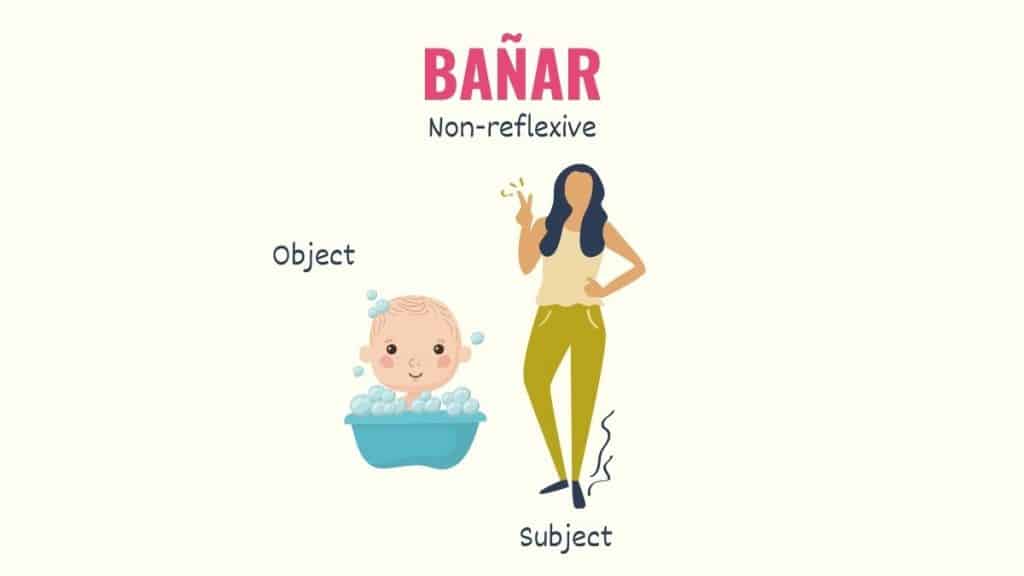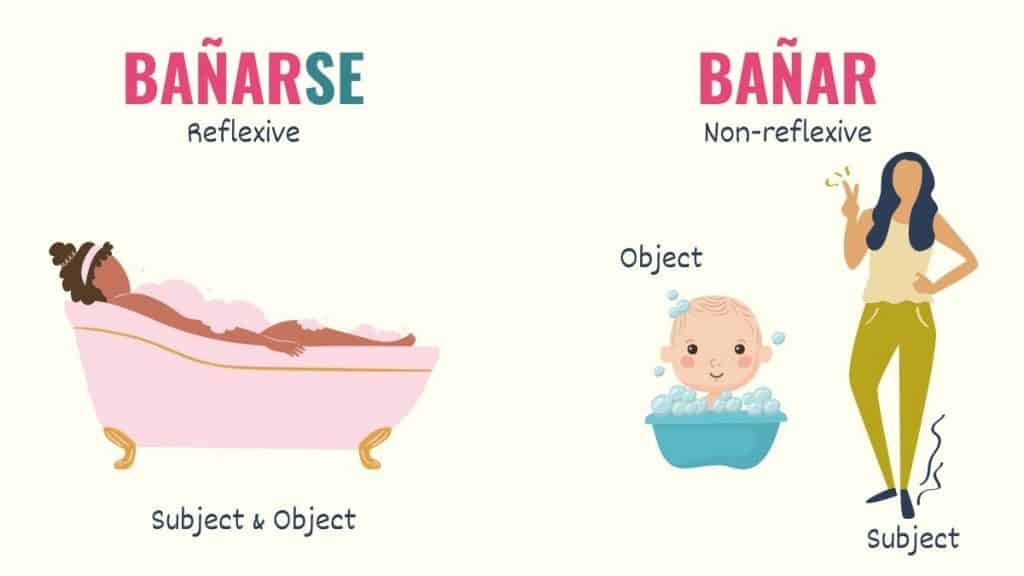In Spanish, reflexive verbs are formed from a regular or non-reflexive verb. For this reason, it’s easy to assume that there’s not a big difference between these types of verbs. But in order to use them correctly, you need to follow certain rules. As a result, many people wonder what’s the difference between reflexive verbs and regular verbs in Spanish.
Reflexive verbs describe that a subject (person) is performing an action on itself. Additionally, in their natural (infinitive) form, reflexive verbs end with ‘se’. Non-reflexive verbs express that an action is performed by a subject and received by a different object. Its endings are: ‘-ar’, ‘-er’ and ‘-ir’.
Knowing the difference between a reflexive and regular verb can be challenging for new and experienced Spanish learners. However, understanding this can help you improve your command of reflexive verbs in Spanish.
For that reason, in the following sections, we’ll explain the difference between these verbs and provide examples and phrase structures that you can follow.
By the end of this, you will be able to tell the difference between reflexive and non-reflexive verbs yourself.
Learning Spanish?
Join the Tell Me In Spanish community and get a copy of my step-by-step Spanish Learner’s Roadmaps and tricky synonyms & vocab cheat sheets.
What’s the Difference Between Reflexive & Non-Reflexive Verbs in Spanish?
When learning reflexive verbs, many Spanish students struggle to understand when they need to use a reflexive verb instead of a regular one and vice versa. Although reflexive verbs are formed with a non-reflexive verb, these verbs work with different grammatical structures.
Reflexive verbs express that a person is performing an action on herself/himself. In other words, these verbs indicate that the subject and the object or beneficiary of the action are the same person. Additionally, in its natural form, reflexive verbs end with ‘se’. ‘Se’ needs to change to indicate who the action is directed at.

Yo me baño
I bath (myself)
On the other hand, non-reflexive verbs are used to express that an action is performed by a subject, and a different object or person is receiving or being affected by this action: subject and object are different entities. The endings of these verbs are: ‘-ar’, ‘-er’ and ‘-ir’.

Yo baño al bebé
I bathe the baby
Take Note: Most of the time the difference between reflexive and non-reflexive verbs depends on who is receiving the action. You? Someone else? However, in some cases, reflexive and regular verbs differentiate in meaning.
| Parar | Pararse |
| To stop | To stand |
| Despedir | Despedirse |
| To fire | To say goodbye |
Now, that you see the main difference between non-reflexive and reflexive verbs, let’s see the structures that you need to follow as well as some examples.
Using Reflexive & Non-Reflexive Verbs
As mentioned before, the main difference between reflexive and non-reflexive verbs is the object that they are working with. In this context, it helps answer the following questions:
- Who is receiving or being affected by the action?
- Is it the same person that is performing the action?
With reflexive verbs, the person performing the action is the person being affected by it (they do the action to themselves). With non-reflexive verbs, one person is performing the action and something or someone else is being affected.
In order to explain this to you, we’ll include some examples with the following verbs in their reflexive and non-reflexive form:
| Bañarse | To shower (oneself) |
| Bañar | To shower |
| Despertarse | To wake up (oneself) |
| Despertar | To wake up |
| Vestirse | To get dressed |
| Vestir | To dress |
Reflexive verbs sentence structure
[Subject] + [reflexive pronoun] + [verb conjugated]
Sandra se baña en la mañana
Sandra showers in the morning
Siempre me despierto temprano
I always wake up early
Nosotros nos vestimos antes de desayunar
We get dressed before having breakfast
Take Note: In their infinitive form, reflexive verbs end with ‘se’. This pronoun ‘se’ needs to change to match the subject of the sentence.
Non-reflexive verbs sentence structure
[Subject] + [verb conjugated] + a + [determiner] + [object]
Sandra baña a su bebé en las mañanas
Sandra showers her baby in the mornings
Yo siempre despierto a mi hermano
I always wake my brother up
Mis papás visten a mi hermanito antes del desayuno
My parents dress my little brother before breakfast
Take Note: With non-reflexive verbs, you can use direct and indirect object pronouns to make your sentences shorter. This is not possible to do with reflexive verbs.
Can All Verbs Be Reflexive in Spanish?
Many people think that just by adding the reflexive ending ‘se’ to a verb they can make it reflexive. However, not all Spanish verbs can be reflexive. Due to its nature, reflexive verbs always need to work with an object who also is the person performing the action. So any Spanish verb that has an object can be transformed into a reflexive verb:
Andrea le compró chocolates a su novio
Andrea bought chocolates for her boyfriend
Yo me compré una caja de chocolates
I bought myself a box of chocolates
But intransitive verbs are verbs that don’t need to work with an object. As a result, these verbs will never have a reflexive form.
Yo trabajo aquí desde hace diez años
I have been working here for ten years
How Many Reflexive Verbs are There in Spanish
Reflexive verbs are not only important in Spanish, but they are also very common in all types of contexts. According to Jaime Suances Torres, there are 523 basic and common Spanish verbs that all speakers use in their conversations.
Almost 30% of these verbs are reflexive verbs. So based on this data, there are 154 basic and common verbs with reflexive form that you may come across at some point. Since reflexive verbs represent a good part of Spanish verbs, it’s important that you learn how and when to use them correctly.
Related Resource: Most Common Reflexive Verbs in Spanish
Wrapping Up
For some Spanish learners, it’s difficult to identify when they need to use a reflexive or a non-reflexive verb. For that reason, in this article, we talked about the differences between these types of verbs.
Even though reflexive verbs are formed from regular verbs, this doesn’t mean that reflexive verbs work the same way as non-reflexive ones. Here are some takeaways to keep in mind:
Reflexive Verbs
- Expresses that a person is performing the action on herself/himself.
- Works with an object. In this case, the subject and the object are the same entity.
- In its infinitive form, its ending is ‘se’.
- Works with a reflexive pronoun to indicate who the action is directed at.
- Reflexive pronouns need to match with the subject performing the action
Non-reflexive / Regular Verbs
- Works with an object that receives or is affected by the action.
- The subject and the object are different entities.
- Works with the preposition ‘a’ to introduce the object receiving the action.
- These verbs have different endings: ‘-ar’, ‘-er’, ‘-ir’.
The object can be replaced with direct and indirect objects pronouns.

Hopefully, now you won’t have issues identifying the differences between reflexive and non-reflexive verbs in Spanish.
Related Resource: Reflexive or Non-Reflexive Verbs Quiz



